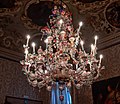Ca 'Rezzonico
Ca 'Rezzonico is a palace on the Grand Canal at the mouth of the Rio Barnaba in the Dorsoduro sestiere in Venice .
history
Originally there were two houses belonging to the Bon family, which belonged to the old nobility of Venice. In 1649 Filippo Bon commissioned the architect Baldassare Longhena to build a new, magnificent palace on this site. Longhena began construction in 1667, which by his death in 1682 had grown to the first floor. Then the work was stopped for several decades because the client had to file for bankruptcy. It was not until 1750 that construction work was continued by the new owners, the Rezzonico family , who entrusted the architect Giorgio Massari with the planning, which essentially followed Longhena's concept. The very rich Rezzonico family, who come from Lake Como , only bought their way into the Venetian nobility in 1687 for 100,000 ducats. In 1758 a member of the family, Carlo Rezzonico, was surprisingly elected Pope, who then became Clement XIII. called. The new building came as it was called for the now papal family to fulfill its representative duties.
After the fall of the Republic of Venice , the family also suffered a financial catastrophe. The house's art treasures were auctioned and eventually the palace was sold. For the next hundred years, the palace had many owners and tenants. In 1885 the son of the poet Robert Browning bought Ca 'Rezzonico with funds from his wife as a domicile for his old father, who died here in 1889. In 1906 the palace was sold to Baron Hirschel de Minerbi, who was awarded the contract before Kaiser Wilhelm II .
In 1935 the city of Venice acquired the palace, which set up the Museum of the Venetian Settecento (18th century) here. During the Second World War , the art protection department of the German Wehrmacht stored the art treasures stolen from Northern Italy here and in Ca 'Pesaro . After the war, the Ca 'Rezzonico was under the Allied Division of Monuments, Fine Arts and Archives (Allied Military Government, Venice Region) . As early as July 20 to November 30, 1945, an exhibition entitled Mostra di Cinque Secoli di Pittura Veneta was able to take place in the Neue Prokuratien with the works of art, many of which came from private collections that were otherwise difficult to access . Mayor Giovanni Ponti wrote the foreword for the catalog .
Building description
Longhena's design of the palace contrasted sharply with the floral Gothic of earlier palaces. The four-story facade facing the Grand Canal is made of marble and reflects the prestige of the builder's family. There is an entrance porch on the ground floor, flanked by two windows each. The seven equal windows on the second and third floors each have a balcony in front of them. Longhena achieves interesting light and dark effects through the deep structure of the facade. The fourth floor has small oval windows. The palace is grouped around an arcaded courtyard with a fountain. The huge ballroom, which extends over two floors and is accessible via a representative staircase, was designed by Massari.
Interior
Today the palace houses the Museo del Settecento Veneziano . We can find paintings and frescoes by Pietro Longhi , Canaletto , Francesco Guardi , father and son Tiepolo , as well as furniture and fittings brought here from other palaces and villas.
From the original equipment are still preserved:
- Pietro Visconti : Trompe-l'œil decoration of the side walls of the ballroom
- Giovanni Battista Crosato : ceiling painting Apollo steers the sun chariot over the continents (ballroom)
- Giovanni Battista Tiepolo : Allegory of the marriage of Ludovico Rezzonicos with Faustina Savargnan
gallery
Veiled Lady by Antonio Corradini
Individual evidence
- ↑ Jan Andreas May: La Biennale di Venezia: Continuity and Change in Venetian Exhibition Policy 1895–1948 (Studi. Series of publications by the German Study Center in Venice ), Berlin 2009, p. 218f.
literature
- Hermann E. Mark: History and stories from the Canal Grande , Ibera Verlag, 2002, p. 357 ff
- Alvise Zorzi : Grand Canal. Biography of a waterway , Claassen, 1993 ISBN 3-546-00057-9
Web links
- Ca 'Rezzonico (PDF), Fondazione Musei Civici di Venezia
- Jan-Christoph Rößler, Venice
- Museo del Settecento Veneziano ( Memento from June 6, 2012 in the Internet Archive )
Coordinates: 45 ° 26 ′ 0.8 ″ N , 12 ° 19 ′ 36.4 ″ E






